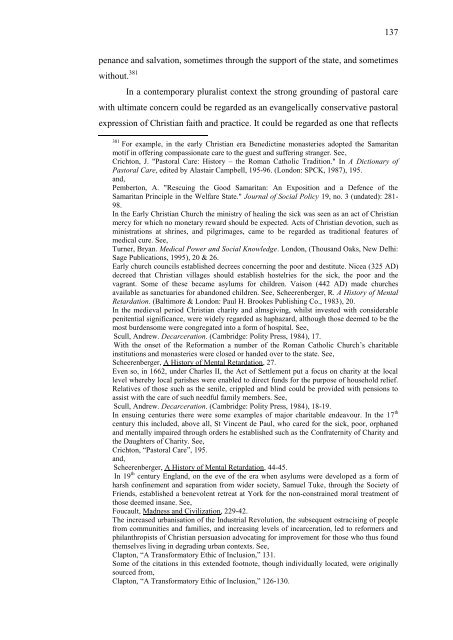Pastoral Relationship with People with Intellectual ... - Theses
Pastoral Relationship with People with Intellectual ... - Theses
Pastoral Relationship with People with Intellectual ... - Theses
Create successful ePaper yourself
Turn your PDF publications into a flip-book with our unique Google optimized e-Paper software.
137penance and salvation, sometimes through the support of the state, and sometimes<strong>with</strong>out. 381In a contemporary pluralist context the strong grounding of pastoral care<strong>with</strong> ultimate concern could be regarded as an evangelically conservative pastoralexpression of Christian faith and practice. It could be regarded as one that reflects381 For example, in the early Christian era Benedictine monasteries adopted the Samaritanmotif in offering compassionate care to the guest and suffering stranger. See,Crichton, J. "<strong>Pastoral</strong> Care: History – the Roman Catholic Tradition." In A Dictionary of<strong>Pastoral</strong> Care, edited by Alastair Campbell, 195-96. (London: SPCK, 1987), 195.and,Pemberton, A. "Rescuing the Good Samaritan: An Exposition and a Defence of theSamaritan Principle in the Welfare State." Journal of Social Policy 19, no. 3 (undated): 281-98.In the Early Christian Church the ministry of healing the sick was seen as an act of Christianmercy for which no monetary reward should be expected. Acts of Christian devotion, such asministrations at shrines, and pilgrimages, came to be regarded as traditional features ofmedical cure. See,Turner, Bryan. Medical Power and Social Knowledge. London, (Thousand Oaks, New Delhi:Sage Publications, 1995), 20 & 26.Early church councils established decrees concerning the poor and destitute. Nicea (325 AD)decreed that Christian villages should establish hostelries for the sick, the poor and thevagrant. Some of these became asylums for children. Vaison (442 AD) made churchesavailable as sanctuaries for abandoned children. See, Scheerenberger, R. A History of MentalRetardation. (Baltimore & London: Paul H. Brookes Publishing Co., 1983), 20.In the medieval period Christian charity and almsgiving, whilst invested <strong>with</strong> considerablepenitential significance, were widely regarded as haphazard, although those deemed to be themost burdensome were congregated into a form of hospital. See,Scull, Andrew. Decarceration. (Cambridge: Polity Press, 1984), 17.With the onset of the Reformation a number of the Roman Catholic Church’s charitableinstitutions and monasteries were closed or handed over to the state. See,Scheerenberger, A History of Mental Retardation, 27.Even so, in 1662, under Charles II, the Act of Settlement put a focus on charity at the locallevel whereby local parishes were enabled to direct funds for the purpose of household relief.Relatives of those such as the senile, crippled and blind could be provided <strong>with</strong> pensions toassist <strong>with</strong> the care of such needful family members. See,Scull, Andrew. Decarceration. (Cambridge: Polity Press, 1984), 18-19.In ensuing centuries there were some examples of major charitable endeavour. In the 17 thcentury this included, above all, St Vincent de Paul, who cared for the sick, poor, orphanedand mentally impaired through orders he established such as the Confraternity of Charity andthe Daughters of Charity. See,Crichton, “<strong>Pastoral</strong> Care”, 195.and,Scheerenberger, A History of Mental Retardation, 44-45.In 19 th century England, on the eve of the era when asylums were developed as a form ofharsh confinement and separation from wider society, Samuel Tuke, through the Society ofFriends, established a benevolent retreat at York for the non-constrained moral treatment ofthose deemed insane. See,Foucault, Madness and Civilization, 229-42.The increased urbanisation of the Industrial Revolution, the subsequent ostracising of peoplefrom communities and families, and increasing levels of incarceration, led to reformers andphilanthropists of Christian persuasion advocating for improvement for those who thus foundthemselves living in degrading urban contexts. See,Clapton, “A Transformatory Ethic of Inclusion,” 131.Some of the citations in this extended footnote, though individually located, were originallysourced from,Clapton, “A Transformatory Ethic of Inclusion,” 126-130.















